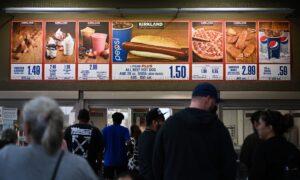Costco has taken in significant revenue since it started selling gold bars online last year, said a Wells Fargo analyst in a note issued on April 9.
The retailer last year started selling one-ounce gold bars for about $2,000 depending on the price of gold. The firm is also selling silver for approximately $675 for a tube of 25 coins.
Wells Fargo estimated that the firm’s revenue for gold “may now be running at” $100 million to $200 million each month, reported CNBC. The major U.S. bank did not provide an estimate for Costco’s silver sales.
“Our work suggests there has been significant interest given Costco’s aggressive pricing and high level of customer trust,” said Edward Kelly, with Wells Fargo, in a note to clients.
“The accelerating frequency of Reddit posts, quick online sell-outs of product, and [Costco’s] robust monthly [ecommerce] sales suggests a sharp uptick in momentum since the launch.”
However, Mr. Kelly suggested that there are limitations. The store gets a low premium on gold bars and further offers 2 percent cash back for executive members and another 2 percent for people who use their Citigroup cards, he noted, according to the outlet.
“Pricing at that level and shipping costs suggests it’s a very low-profit business at best,” the Wells Fargo analyst wrote, adding that the sales are adding 3 percent to general merchandise sales but appear not to be contributing to Costco’s profits.
Gold Hits Record High
Gold prices hit a record high on April 8 for a seventh straight session, in part fueled by central bank purchases and geopolitical tensions.Spot gold was up 0.1 percent at $2,341.85 per ounce by 12:08 p.m. ET after hitting a record high of $2,365.09. U.S. gold futures gained 0.4 percent to $2,360.70.
“Technical buying momentum will continue in the gold market unless the CPI data comes out much hotter than expected. A cooler inflation report could take prices to $2,400,” said Phillip Streible, chief market strategist at Blue Line Futures in Chicago, according to Reuters.
The U.S. Federal Reserve’s policy meeting minutes and U.S. Consumer Price Index data, a key measure of inflation, are due to be released on April 10.
Central banks have been large buyers of gold in recent months, mainly in Asia. China’s central bank added 160,000 troy ounces of gold to its reserves in March. Turkey, India, Kazakhstan, and some eastern European countries also have been buying gold this year.
“The market is pricing rate cuts by June despite strong economic data. But, if we continue to see strong data, which indicates that Federal Reserve is in no hurry to cut rates, then gold will not be able to sustain the gains,” said Bart Melek, head of commodity strategies at TD Securities, Reuters reported.
“Central bank buying and geopolitical tensions are other supportive elements,” he added.
Gold purchases are also likely to pick up later in the year, according to DataTrek Research cited by CNBC.
“The move suggests that many foreign governments feel the need to hedge geopolitical outcomes that might be negative catalysts for other risk assets like stocks,” DataTrek co-founder Nicholas Colas said, according to the report.
“The only good news is that this reinforces the idea of gold as a reasonable hedge for diversified portfolios.”
Gold bullion and other precious metals are considered a hedge against inflation and geopolitical uncertainties, but higher interest rates tend to dull the appeal of holding the non-yielding asset.
“With the prospect of lower interest rates ahead, the suggestion is that (gold exchange-traded-funds) ETFs have missed the rally and are now under-allocated.”
By the end of March, the group noted, gold prices hit new highs, increasing more than 8 percent for the month.
“Geopolitical tensions convulsed across several fronts,” it said, adding that U.S. data suggest “stagflation risks might be on the rise again,” another supportive development for gold prices.







